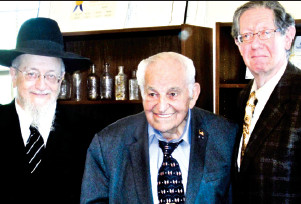Parise among GIs who liberated Buchenwald
“I’m no hero,” Cedarhurst Mayor Andrew Parise told a class of high school students last year, just before the 70th anniversary of D-Day, when Allied forces landed in Europe to defeat the Nazis. “I was one of thirteen-and-a-half million soldiers that went to fight. The heroes are there, they never came home, they are still there, buried.” His unit literated Buchenwald.
In Cedarhurst Town Hall, where he greeted the students, Parise sat at a table convered with artifacts from his time in Europe — a bayonet from an M1 rifle, a pin from a hand grenade, various Nazi knives and a framed case of Nazi paraphernalia. A framed case held Parise’s medals from his time in the Army.
The visitors accompanied their World History Regents teacher, The Jewish Star’s Bookworm columnist, Alan Jay Gerber, from Yeshiva Derech HaTorah in Brooklyn.
Rabbi Yaakov Feitman of Kehillas Bais Yehudah Tzvi in Cedarhurst told the students that his father was at Buchenwald, and “I am here because he [Parise] was there.”
“They almost succeeded in wiping out the Jews,” said Rebbitzen Cynthia Zalinsky, executive director of the Jewish Community Council of Queens, blinking back tears, as she thanked Mayor Parise. As a result of saving her father, Parise would see four generations — with Zalinsky, her son and his children in were the room.
She told the students: “You need to bear witness [and say], I met someone who freed the Jews in Buchenwald.”
Parise said thanked the speakers for their “kind remarks,” denied his heroism and briefly described his division’s record 154 days on the front lines under grueling conditions.
He was awarded a Purple Heart when he was shot by a sniper in the backs of his legs shortly before the end of the war. “I was dismantling tank obstacles,” he explained. “The Germans would cut huge trees [down] so the tanks won’t pass.” He recalled fighting 30 days in the forest, with snow four to five feet deep, that soldiers froze to death and they had to chop them out of the ice and carried them on box springs they found to the trucks.

 52.0°,
Overcast
52.0°,
Overcast 




